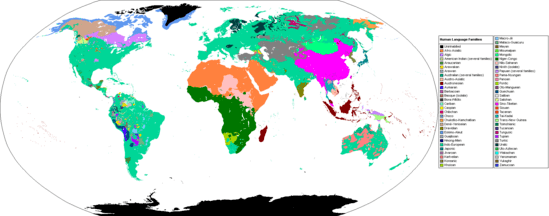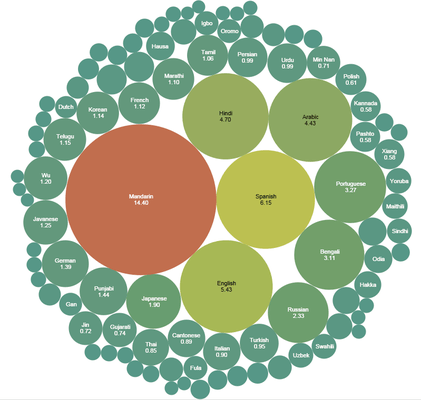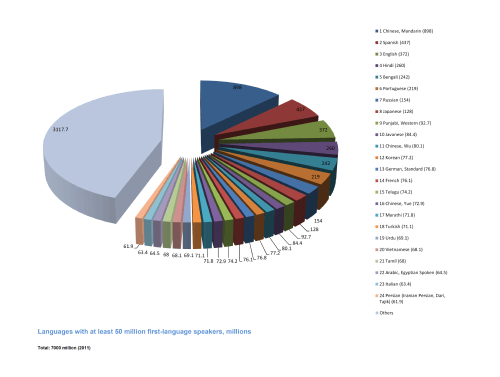List of languages by number of native speakers

This article ranks human languages by their number of native speakers.
However, all such rankings should be used with caution.[1] It is difficult to define the difference between a language and a dialect, or between a language and a macrolanguage; for example, Chinese is sometimes considered a single language and sometimes a macrolanguage whose many varieties are all independent languages. Any division of speakers among languages is the result of the classification of these speakers. Often such classifications are based on political or cultural factors. Although such classifications are not entirely arbitrary, it is not possible to devise a coherent linguistic set of criteria for the boundaries between languages.
For a list of languages with the smallest numbers of native speakers, see lists of endangered languages.
Top languages by population
The following table contains the top 100 languages by estimated number of native speakers in the 2007 edition of the Swedish encyclopedia Nationalencyklopedin. As census methods in different countries vary to a considerable extent, and given that some countries do not record language in their censuses, any list of languages by native speakers, or total speakers, is effectively based on estimates. Updated estimates from 2010 are also provided.[2]
The top eleven languages have additional figures from the 2010 edition of the Nationalencyklopedin. Numbers above 95 million are rounded off to the nearest 5 million.
| Rank | Language | Native speakers in millions 2007 (2010) |
Percentage of world population (2007) |
|---|---|---|---|
| 1 | Mandarin (entire branch) | 935 (955) | 14.1% |
| 2 | Spanish | 390 (405) | 5.85% |
| 3 | English | 365 (360) | 5.52% |
| 4 | Hindi[lower-alpha 1] | 295 (310) | 4.46% |
| 5 | Arabic | 280 (295) | 4.23% |
| 6 | Portuguese | 205 (215) | 3.08% |
| 7 | Bengali (Bangla) | 200 (205) | 3.05% |
| 8 | Russian | 160 (155) | 2.42% |
| 9 | Japanese | 125 (125) | 1.92% |
| 10 | Punjabi | 95 (100) | 1.44% |
| 11 | German | 92 (95) | 1.39% |
| 12 | Javanese | 82 | 1.25% |
| 13 | Wu (e.g. Shanghainese) | 80 | 1.20% |
| 14 | Malay (inc. Malaysian and Indonesian) | 77 | 1.16% |
| 15 | Telugu | 76 | 1.15% |
| 16 | Vietnamese | 76 | 1.14% |
| 17 | Korean | 76 | 1.14% |
| 18 | French | 75 | 1.12% |
| 19 | Marathi | 73 | 1.10% |
| 20 | Tamil | 70 | 1.06% |
| 21 | Urdu | 66 | 0.99% |
| 22 | Turkish | 63 | 0.95% |
| 23 | Italian | 59 | 0.90% |
| 24 | Yue (incl. Cantonese) | 59 | 0.89% |
| 25 | Thai | 56 | 0.85% |
| 26 | Gujarati | 49 | 0.74% |
| 27 | Jin | 48 | 0.72% |
| 28 | Southern Min (incl. Hokkien and Teochew) | 47 | 0.71% |
| 29 | Persian | 45 | 0.68% |
| 30 | Polish | 40 | 0.61% |
| 31 | Pashto | 39 | 0.58% |
| 32 | Kannada | 38 | 0.58% |
| 33 | Xiang (Hunanese) | 38 | 0.58% |
| 34 | Malayalam | 38 | 0.57% |
| 35 | Sundanese | 38 | 0.57% |
| 36 | Hausa | 34 | 0.52% |
| 37 | Odia (Oriya) | 33 | 0.50% |
| 38 | Burmese | 33 | 0.50% |
| 39 | Hakka | 31 | 0.46% |
| 40 | Ukrainian | 30 | 0.46% |
| 41 | Bhojpuri | 29[lower-alpha 2] | 0.43% |
| 42 | Tagalog (Filipino) | 28 | 0.42% |
| 43 | Yoruba | 28 | 0.42% |
| 44 | Maithili | 27[lower-alpha 2] | 0.41% |
| 45 | Uzbek | 26 | 0.39% |
| 46 | Sindhi | 26 | 0.39% |
| 47 | Amharic | 25 | 0.37% |
| 48 | Fula | 24 | 0.37% |
| 49 | Romanian | 24 | 0.37% |
| 50 | Oromo | 24 | 0.36% |
| 51 | Igbo | 24 | 0.36% |
| 52 | Azerbaijani | 23 | 0.34% |
| 53 | Awadhi | 22[lower-alpha 2] | 0.33% |
| 54 | Gan Chinese | 22 | 0.33% |
| 55 | Cebuano (Visayan) | 21 | 0.32% |
| 56 | Dutch | 21 | 0.32% |
| 57 | Kurdish | 21 | 0.31% |
| 58 | Serbo-Croatian | 19 | 0.28% |
| 59 | Malagasy | 18 | 0.28% |
| 60 | Saraiki | 17[lower-alpha 3] | 0.26% |
| 61 | Nepali | 17 | 0.25% |
| 62 | Sinhalese | 16 | 0.25% |
| 63 | Chittagonian | 16 | 0.24% |
| 64 | Zhuang | 16 | 0.24% |
| 65 | Khmer | 16 | 0.24% |
| 66 | Turkmen | 16 | 0.24% |
| 67 | Assamese | 15 | 0.23% |
| 68 | Madurese | 15 | 0.23% |
| 69 | Somali | 15 | 0.22% |
| 70 | Marwari | 14[lower-alpha 2] | 0.21% |
| 71 | Magahi | 14[lower-alpha 2] | 0.21% |
| 72 | Haryanvi | 14[lower-alpha 2] | 0.21% |
| 73 | Hungarian | 13 | 0.19% |
| 74 | Chhattisgarhi | 12[lower-alpha 2] | 0.19% |
| 75 | Greek | 12 | 0.18% |
| 76 | Chewa | 12 | 0.17% |
| 77 | Deccan | 11 | 0.17% |
| 78 | Akan | 11 | 0.17% |
| 79 | Kazakh | 11 | 0.17% |
| 80 | Northern Min | 10.9 | 0.16% |
| 81 | Sylheti | 10.7 | 0.16% |
| 82 | Zulu | 10.4 | 0.16% |
| 83 | Czech | 10.0 | 0.15% |
| 84 | Kinyarwanda | 9.8 | 0.15% |
| 85 | Dhundhari | 9.6[lower-alpha 2] | 0.15% |
| 86 | Haitian Creole | 9.6 | 0.15% |
| 87 | Eastern Min (inc. Fuzhounese) | 9.5 | 0.14% |
| 88 | Ilocano | 9.1 | 0.14% |
| 89 | Quechua | 8.9 | 0.13% |
| 90 | Kirundi | 8.8 | 0.13% |
| 91 | Swedish | 8.7 | 0.13% |
| 92 | Hmong | 8.4 | 0.13% |
| 93 | Shona | 8.3 | 0.13% |
| 94 | Uyghur | 8.2 | 0.12% |
| 95 | Hiligaynon/Ilonggo (Visayan) | 8.2 | 0.12% |
| 96 | Mossi | 7.6 | 0.11% |
| 97 | Xhosa | 7.6 | 0.11% |
| 98 | Belarusian | 7.6[lower-alpha 4] | 0.11% |
| 99 | Balochi | 7.6 | 0.11% |
| 100 | Konkani | 7.4 | 0.11% |
| Total | 5,610 | 85% |
Charts and graphs
 Bubble chart of languages by proportion of native speakers worldwide[2]
Bubble chart of languages by proportion of native speakers worldwide[2] Languages with at least 50 million first-language speakers, millions (according to: Ethnologue[4])
Languages with at least 50 million first-language speakers, millions (according to: Ethnologue[4])
See also
- Global language system
- Linguistic demography
- Linguistic Diversity Index
- List of ISO 639-3 codes
- List of languages by total number of speakers
- List of languages by number of native speakers in Africa
- List of languages by number of native speakers in India (uses a different definition of Hindi)
- List of sign languages by number of native signers
- Lists of languages
- World language
- Languages used on the Internet
Notes
- ↑ Refers to only Modern Standard Hindi here. The Census of India defines Hindi on a loose and broad basis. It does not include the entire Hindustani language , only the Hindi register of it. In addition to Standard Hindi, it incorporates a set of other Indo-Aryan languages written in Devanagari script including Awadhi, Bhojpuri, Haryanvi, Dhundhari etc. under Hindi group which have more than 422 million native speakers as of 2001.[3] However, the census also acknowledges Standard Hindi, the above mentioned languages and others as separate mother tongues of the Hindi language and provides individual figures for all these languages.[3]
- 1 2 3 4 5 6 7 8 This is only a fraction of total speakers; others are counted under "Hindi" as they regard their language a Hindi dialect.
- ↑ Numbers may also be counted in Punjabi above
- ↑ Only half this many use Belarusian as their home language.
References
- ↑ Paolillo, John C.; Das, Anupam (31 March 2006). "Evaluating language statistics: the Ethnologue and beyond" (PDF). UNESCO Institute of Statistics. pp. 3–5. Retrieved 8 October 2015.
- 1 2 Mikael Parkvall, "Världens 100 största språk 2007" (The World's 100 Largest Languages in 2007), in Nationalencyklopedin. Asterisks mark the 2010 estimates for the top dozen languages.
- 1 2 Abstract of speakers' strength of languages and mother tongues – 2000, Census of India, 2001
- ↑ Summary by language size
External links
- The Ethnologue's most recent list of languages by number of speakers
- Languages Spoken by More Than 10 Million People (Archived 2009-10-31) – Encarta list, based on data from Ethnologue, but some figures (e.g. for Arabic) widely vary from it
- Map of World Languages. Download of MP3 audio files in 1600 language combinations.